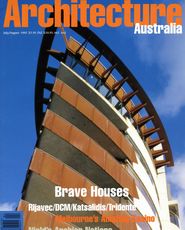Dishwasher PornographyI wish to formally express my deepest concerns with respect to an advertisement for ASKO published inside the front covers of your January/February and March/April 1997 magazines. I do not appreciate opening my magazines and seeing pornography as portrayed in this form. I could quite easily go to the newsagents and buy magazines of that nature if I see fit. I have very clear values and have chosen a path that would exclude this type of advertising or media of any form. I therefore do not want it thrust upon me. It does offend me and I ask that you review this advertising. —From JA Cannon, Castle Hill, NSW AA regrets any offence but takes the view that this advertisement is within the boundaries of prevailing community attitudes. As an example, comparable but more explicit images of darkly shadowed female bodies have appeared in another Australian design magazine’s recent cover story on office furniture-Ed. Sexism in ArchitectureHaving migrated from the discipline of architecture to construction management, as a woman I have been forced to confront some unfavourable cross-cultural differences. I am of course referring to sexist language and behaviour. I have often been left frustrated by the subtle and sometimes overt sexist attitudes of co-workers but never so horrified as the day I received my invitation to the 1997 RAIA Gold Medal presentation. The first paragraph reads: ‘The Award is a celebration of the architect and his architecture’. Are we to assume that women do not produce architecture worthy of merit? Or have we been reduced to the role of the woman on page 2, AA March/April 1997; or the woman on page 86, AA May/June 1996; or the woman on page 64, AA November/December 1995; or maybe the woman on page 112 AA July/August 1995? Speaking from experience, I have found that a female pubescent leaning suggestively across a laminate benchtop has always encouraged me to specify the product. —From Anna Martiniello, Fitzroy, Victoria All RAIA Gold Medals have been awarded to men. The honour is bestowed for outstanding contributions to the profession (not only producing architecture of merit) over a long career. The juries usually select recipients aged over 50 (often over 60) who have been principals of prominent private practices, active in the RAIA, teachers at architecture schools and regular public speakers on urban affairs-Ed. Ignorance of BuildingArchitects design buildings and are expected to ensure that they are built properly. An architect should therefore know how to tell a sound brick from an under-burnt one, should know without looking it up how to specify the mixes for plastering a wall and should be able to design a simple reinforced concrete beam. He or she should know without consulting an engineer whether a simple retaining wall would be stable or not, or if a flat roof would be weatherproof. These are all examples in my experience of some architects’ fundamental ignorance of building elements. Such ignorance results, I believe, from the great changes in architectural education which took place after World War II. Before that, most would-be architects worked in an architect’s office and studied part-time in schools of architecture; or at least, if already in full-time courses like those at Perth Technical College, spent some time in workshop practice learning how to drive a nail. Now, however, students spend all their time at university and only if they are lucky pick up some of the basics of building construction. Admittedly, in some countries architects may have a different role. In France, for instance, when last heard of, architects were confined to the fine art aspects of building and left the construction to technicians who were suitably skilled. But in Australia, architectural graduates may complete their course, get registered and then be let loose on the public. Gradually they may pick up the essentials of good building practice but many will not. The better way is by the accumulation of experience from day-to-day contact with practical building. It is not surprising that architects as a whole are not considered to be the chief building expert that the word ‘architect’ implies. The solution, as I am not the first to say, would be the return to the apprenticeship system; not necessarily under legal articles but with hands-on contact with the construction of buildings while employed in an architect’s office. The same could probably be said for any other aspect of architectural practice such as contract administration, planning, building services and so on. Skill in design and presentation alone is not enough. —From Frederick McCardell, Floreat, WA Court Defendant Not an ArchitectWe have been contacted about an item on p 20 of the May/June issue of Architecture Australia, which reported that “James Martakis, an architect with MHK in Richmond …” Mr Martakis is not, and never has been, registered as an architect. The Board is concerned that he not be represented as such, and I am sure that you would concur with the need for accuracy in your journal. The Board is also unhappy about the use of the abbreviation of the firm’s title, from Martakis Hernandez Kruspe, because it believes the public should be able to identify the principals of a partnership. However, I acknowledge the practical journalistic constraints of space. Could I therefore suggest a brief correction be noted in a future issue? The sensitivities of architects are always excited by any mention of an unregistered person. We are of course always available to answer any question about registered status by telephone or by fax and without charge and certainly without delay, but we do recognise that publishing timelines and realities make it difficult to check every such matter. —From Jeffrey Keddie, Architects Registration Board of Victoria AA’s Radar note that South Yarra city councillor James Martakis had been convicted on a charge of assault was based upon a report in The Age which also stated that the defendant was an architect and named his firm as MHK. When AA called Martakis Hernandez Kruspe to clarify the office’s circumstances, the phone was answered by a man who confirmed that we had reached the practice but who hung up after we identified ourselves and asked to speak to James Martakis. We have since been advised that two of the firm’s three partners are registered architects, so James Martakis is a director of an architectural office, even though not personally qualified with professional credentials. | Radar Off the AirPlease get it correct! If the Queensland correspondent for Radar Headlines (AA May/June 1997) had bothered to telephone me, he would have learnt that my name is Robin (not Robert) and I could have discovered how he had the idea that the Waltzing Matilda Centre at Winton was to be “a museum of colonial-style buildings”. —From Robin Retchford, The Gap, Queensland Marketing versus ProfessionalismI am sure we all enjoy Mr Don Bailey’s ‘bon mots’ (Letters, AA May/June 1997) but I for one have learned to take them not entirely seriously. Mr Bailey’s view is that marketing and professionalism are incompatible. I suppose it depends on what he means by these terms. I have been pleased to assist in gaining corporate sponsorship not only for Chapter Awards (marketing?) but also PD seminars (professionalism?). No sponsor has ever suggested we endorse any preferential treatment and sadly I have not even been offered any gratuities. In fact, many of our sponsors are scrupulously fair and also sponsor other professional bodies such as the Building Designers Association. Mr Bailey seems to hanker for a previous professional state of grace, or at least position on a pedestal, and he would have my unqualified support if I felt for one moment that this position would, Canute-like, reverse the contemporary tide. No! I think we should grasp the marketing nettle in a creative, rigorous and above all professional manner to advance our profession, ie. to rule the waves but not to waive the rules. Perhaps the current Registrar of the NSW Board of Architects could assist by raising the Board’s public profile? Who knows, he might even get some sponsorship. I’d like to see that! —From Andrew Conacher, Wollongong East, NSW CongratulationsCongratulations on the fantastic performance of Architecture Australia at the Bell Awards. The five honours are well deserved. —From Sue Averay, RAIA, Adelaide Interpreting the PigWeldon’s contribution to AA May/June, the ‘Third Little Pig’ cartoon, is very good in that it opens the way to various associated interpretations. In the tale as told conventionally, the third little pig of course is more highly regarded than his peers. At the same time, another interpretation is possible. That the tale is a giant corporate bluff arising from t.l.p working in collusion with the big bad wolf. Their goal: to discredit the first and second little pigs who were working with environmentally benign and cost-effective straw bale and recycled timber construction systems. —From Emilis Prelgauskas, Monarto, SA Table of NonsenseYou published (AA March/April 1997) a table of performance scores of 15 schools of architecture ranked against six criteria, showing that some schools performed, in the opinions of their respective graduates, hugely better than others. As published, the table is nonsense and no more than a silly (and two years old) scoreboard. For example, Queensland scored 19 for ‘good teaching’ while poor old Adelaide copped a miserable -30. What can these scores mean? What measures were used? And what is ‘good teaching’ or a ‘generic skill’? You don’t give us any of the relevant values or criteria. The article implies an insultingly low estimate of your readers’ numeracy. The findings are of considerable importance to many people and far too serious to be presented so casually as an editorial filler. —From Peter Kesteven, Shenton Park, WA While this table of graduate responses is debatable, it represents the latest and best comparative information on perceptions of teaching in Australia’s architecture schools which the RAIA’s National Education Committee is prepared to let us publish. It appears that the RAIA’s policy to deny publication of accreditation committee reports on every school is a response to acute sensitivities among the universities about relative rankings, reputations and financial viability in the current environment of competition for students and funding-Ed. Frank Lloyd Wright Portfolios AvailableI have some Frank Lloyd Wright material for sale: selected drawings portfolios volumes 1, 2 and 3. For further information contact the writer on (07) 5533 2200. —From Peter Jansen, Gilston, Queensland The CSIRO Questions Reduced Design FeesThe RAIA, through the Australian Council of Building Design Professions, is supporting a study by the CSIRO into the effects of reduced design fees on design and documentation quality and its effect on construction process efficiency. Preliminary results from industry workshops indicate that this study is likely to have a major impact on the whole development industry. However its success will totally depend on industry response to questionnaires currently being prepared to quantify the the extent of the problem. It is hoped that all members of the RAIA will all actively support this research by promptly and honestly completing and returning the questionnaires; expected to be distributed around the beginning of August 1997. It is obviously in the interests of ourselves and the profession, if the study is a success. If you would like to know more, contact me on (07) 3214 2117. —From Paul Tilley, CSIRO, Brisbane Credit FixesIn AA March/April, Robert Creed‘s name was mis-spelt in the credits for the Pavilion on the Park restaurant by Tony Masters Design. In AA May/June, Patrick Bingham-Hall photographed the Cox and Peddle Thorp buildings and models shown in our Olympics feature.
|
Letters: Architecture Australia, July 1997
More archive
See all
A preview of the November 2020 issue of Landscape Architecture Australia.














